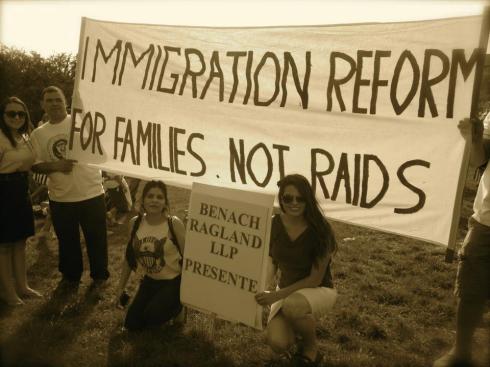The House of Representatives passed the Enforce Act yesterday. This piece of legislation, which is never going to become law, provides a cause of action to Members of Congress to sue the President for failure to enforce the laws as they see fit. The Enforce Act is aimed squarely at the President’s Deferred Action for Childhood Arrivals program, which has given hope to so many young undocumented immigrants. How this vote fits with the immigration statement of principles that the House GOP released in January is beyond us. When in doubt, votes, much more than “statements of principles,” reflect where Congress truly is. And the House actually managed to get worse on immigration. So, in case, it is not perfectly clear- THE HOUSE HAS NO INTENTION OF PASSING ANY MEANINGFUL IMMIGRATION REFORM. IF THE PRESIDENT WANTS TO BE A CHAMPION OF IMMIGRANTS, HE NEEDS TO DO SO ON HIS OWN. Got it??
My internet marketing professionals tell me that lists are very effective ways to get readers to a blog. And cats in a foul mood.
So, here are nine things that the President could do administratively to grant some relief from the deportation machine. That is, nine things that the President could do without Congress acting. Any of these steps would ease the deportation crisis and provide relief and assistance to hundreds of thousands of people left hopeless by Congressional inaction.
Now, we have heard a lot from this President that he does not have the authority to simply ignore the law. That simple statement is true enough. However, the President does have broad authority to determine how to interpret ambiguous statutory language. And the Immigration and Nationality Act is pretty darn ambiguous. For example, Congress has stated that cancellation of removal for people who are not permanent residents is limited to those who have U.S. citizen or permanent resident family members who would suffer “exceptional and extremely unusual hardship” if the applicant were deported. It is the role of the immigration agencies to define what is “exceptional and extremely unusual hardship.” Whereas the Board of Immigration Appeals has been pretty stingy with that standard, the agency could depart from such a parsimonious interpretation and create a more generous standard. The President’s power to fill-in the details and context of statutes was discussed by the Supreme Court in Chevron v. National Resources Defense Council. In that case, the Supreme Court stated that it will defer to an agency’s reasonable interpretation of ambiguous statutory language. As a practical matter, where a court finds a statutory command to be ambiguous, it will almost always defer to the agency’s interpretation of the statute. Most statutory language is ambiguous. Recently, for example, courts of appeals have found the term “when the alien is released” to be ambiguous as to time. If an agency’s interpretation conflicts with an ill-expressed Congressional mandate, the Court reasoned, Congress could legislate more specifically. It is here that the President can use Congressional inaction in his favor. Since Congress seems incapable of passing any legislation, it is unlikely that the President’s liberalized policies will be overturned by a vengeful Congress.
Another Supreme Court case sheds some light on the powers of Congress vis-a-vis the President. In INS. v. Chadha, the Supreme Court invalidated a statutory scheme in which the House of Representatives could veto a INS decision to grant relief from removal known as suspension of deportation to a particular individual. The Court reasoned that the power to decide particular immigration cases has been delegated by statute to the executive and that it violated the Separation of Powers for the Congress to be able to veto a decision regarding a particular individual. This case shows that Congress may disapprove of decisions that the agency makes, but absent legislation, can not do anything about them. Again, the difficulty of getting legislation through Congress gives the President a lot of leeway.
Presumably, the President, a constitutional law professor, knows all that, so he is ready to take actions that would dramatically improve the lives of immigrants in America, re-capture his status as “immigration reform champion in chief,” and get himself measured for a monument on the Mall.
- Parole in place. This is the big kahuna of administrative reform. Parole in place is a mechanism that would allow the agency to “parole” individuals who entered without inspection into the U.S. While parole is normally thought of as something done to allow people to enter the U.S., parole in place allows the government to parole them from within the U.S. The administration recently did this for the undocumented spouses of members of the U.S. military, but there is no reason why the concept can not be applied to tens of thousands of others. Through parole in place, people who have U.S. citizen family members or job offers may be able to adjust their status. Friends of Benach Ragland (FOBRs) Cyrus Mehta and Gary Endelman wrote the definitive piece on parole in place, so we will not go into excessive detail here.
- Reconsider Matter of Rojas. In Matter of Rojas, the BIA held that ICE may hold someone as a mandatory detainee regardless of how long it has been since the individual was released from criminal custody when ICE encounters the immigrant. Many district courts have held that a person is only subject to mandatory detention if ICE apprehends them “when released” from criminal custody. By reconsidering Rojas, ICE would allow immigration judges to determine whether particular individuals are dangerous or likely to flee before a removal hearing. This would have the effect of drastically reducing the detained population.
- Redefine custody. Alternatively, ICE could interpret “custody” to include alternatives to detention such as ankle bracelets and home monitoring, as many criminal agencies do.
- Issue a regulation stating that the separation of a parent from U.S. citizen child is, per se, presumptively “exceptional and extremely unusual hardship.” This would allow parents of U.S. citizens to have more solid claims to cancellation of removal, removing the biggest obstacle to grants of cancellation of removal. The INS created a presumption of hardship before when it issued regulations under
 NACARA allowing certain Central American and Eastern European immigrants to seek suspension of deportation. The INS issued a regulation stating that NACARA applicants were entitled to a presumption of extreme hardship. The immigration agency would be free to limit the presumption of exceptional and extremely unusual hardship, but should begin with the recognition that deporting the parent of a U.S. citizen child is an inherently traumatic act with horrific long term consequences.
NACARA allowing certain Central American and Eastern European immigrants to seek suspension of deportation. The INS issued a regulation stating that NACARA applicants were entitled to a presumption of extreme hardship. The immigration agency would be free to limit the presumption of exceptional and extremely unusual hardship, but should begin with the recognition that deporting the parent of a U.S. citizen child is an inherently traumatic act with horrific long term consequences. - Issue a directive to ICE and CBP stating that, unless significant criminal issues are present, the agencies should decline to enter administrative removal orders and instead seek removal through removal proceedings in immigration court. DHS issues a wide variety of administrative removals. Only about one-third of removal orders are entered by an immigration judge. The rest are issued by ICE either due to reinstatement of a prior removal order, visa waiver overstays, expedited removal of arrivals and of non-resident criminals and voluntary returns. DHS could issue a directive (not guidance or suggestions but orders) requiring ICE to bring these cases before an immigration judge, where the individual could apply for relief.
- Issue a directive to ICE attorneys in immigration court to seek two year continuances in all cases in immigration court where there is no criminal ground of removability and no relief. This would force ICE to work on the hardest cases and clear the backlog of cases where a person has done nothing more than entered illegally or overstayed a visa.
- Issue a directive that detainers should only be lodged where a person has been convicted of a deportable offense. Detainers are issued to people who have been arrested regardless of whether there is a conviction. Removal proceedings are often started due to an arrest that does not lead to any criminal charge because a detainer has been issued. Limit detainers only to those who have been convicted of a deportable offense.
- Issue a precedent decision affirming the low standard for the exceptions to the one year rule for asylum. The law requires an asylum applicant to seek asylum within one year of entry to the U.S. There are exceptions to this rule and the statute requires that an applicant must prove the applicability of the exception “to the satisfaction of the attorney general.” This is the lowest legal standard. Yet, courts routinely hold applicants to a much higher standard. The Attorney General can issue a decision making it clear to the courts that the exception to the one year rule should be liberally applied.

- Grant Temporary Protected Status to Mexicans, Salvadorans, Guatemalans, Hondurans, Venezuelans, and Ukrainians. Temporary Protected Status is granted to nationals of countries where there is disaster or upheaval. It provides individuals already in the U.S. with temporary status, protection against removal, and work authorization. It is possible to make a cogent claim to TPS for each of those countries. Mexico and the Central American countries have been beset by drug and gang violence creating a humanitarian disaster on the ground and Ukraine is the flashpoint of a major crisis in Europe. These are all legitimate uses of Temporary Protected Status.
The House’s action yesterday makes it clear that the House has no intention of moving on immigration reform. The only thing that the President has to lose is his dwindling support in the immigrant community. And he loses that by not acting, rather than acting.














